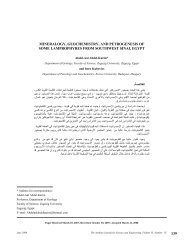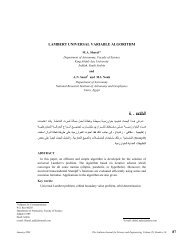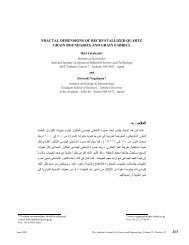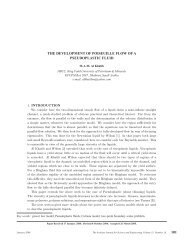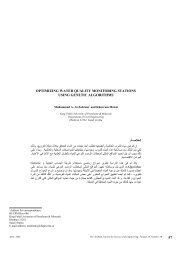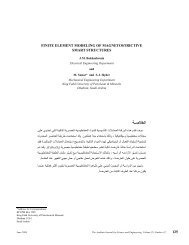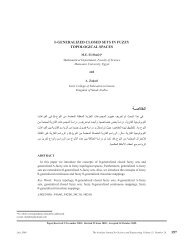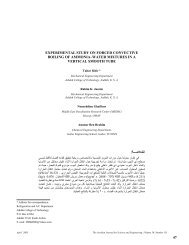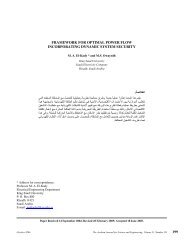اﻟﺨﻼﺻــﺔ - Arabian Journal for Science and Engineering
اﻟﺨﻼﺻــﺔ - Arabian Journal for Science and Engineering
اﻟﺨﻼﺻــﺔ - Arabian Journal for Science and Engineering
You also want an ePaper? Increase the reach of your titles
YUMPU automatically turns print PDFs into web optimized ePapers that Google loves.
A STUDY OF THE SHAPE OF ACTIVATED COMPLEX IN<br />
REACTION BETWEEN POTASSIUM PEROXYDISULFATE<br />
AND POTASSIUM IODIDE<br />
ﺔــﺻﻼﺨﻟا<br />
ﻦﻴﺑو ، ﺖﻴﻔﻠﺳ ياد ﻲﺴآوأﺮﻴﺑ مﻮﻴﺳﺎﺗﻮﺑ ﻦﻴﺑ ﻞﻋﺎﻔﺘﻟا لﺪﻌﻣ ﺖﺑﺎﺛ سﺎﻴﻘﺑ ﺚﺤﺒﻟا اﺬه ﻲﻓ ﺎﻨﻤﻗ<br />
ﺔﺟردو<br />
ﺔﻳﻮﺌﻣ<br />
( ٠٫١ + ٣٠)<br />
ةﺪﻘﻌﻤﻟا<br />
تﺎﺒآﺮﻤﻟا رﺎﻄﻗأ فﺎﺼﻥأ ﺎﻨﺒﺴﺡو<br />
ﻲﻥﺎﻴﺒﻟا ﻢﺳﺮﻟا ﻲﻓ طﻮﻄﺨﻟا<br />
ﺔﺟرد ﺪﻨﻋ نﻮﺘﻴﺳﻷاو ءﺎﻤﻟا ﻦﻣ ﻂﻴﻠﺧ ﻲﻓ ﻚﻟذو ، مﻮﻴﺳﺎﺗﻮﺒﻟا ﺪیدﻮی<br />
ﻞﻴـَﻣ<br />
. ( µ )<br />
ماﺪﺨﺘﺳﺎﺑ ﻚﻟذو ،<br />
ﻦیﺄﺘﻟا ةﺪﺷ ﻢﻴﻗ ﻦﻣ دﺪﻌﻟ<br />
( ٠٫١ + ٤٠)<br />
July 2003 The <strong>Arabian</strong> <strong>Journal</strong> <strong>for</strong> <strong>Science</strong> <strong>and</strong> <strong>Engineering</strong>, Volume 28, Number 2A. 137<br />
ﺔﻳﻮﺌﻣ<br />
ةﺮﻜﻟا<br />
ﻲﺉﺎﻨﺛو يدﺎﺡأ جذﻮﻤﻥﻷ<br />
ﺔﻄﺸﻨﻤﻟا<br />
ﺖﺑﺎﺛ سﻮﻜﻌﻣ ﻦﻴﺑو – ﺮﻔﺹ = ﻦیﺄﺘﻟا ةﺪﺷ نﻮﻜﺗ ﺎﻣﺪﻨﻋ – لﺪﻌﻤﻟا ﺖﺑﺎﺛ ﻦﻴﺑ ﻲﻤﺛرﺎﻏﻮﻠﻟا<br />
. ( ١/<br />
٤)<br />
لﺰﻌﻟا<br />
ةﺪﻘﻌﻤﻟا تﺎﺒآﺮﻤﻠﻟ ﻒﻴﺹﻮﺗ ﻞﻀﻓأ ﻲﻄﻌی<br />
ةﺮﻜﻟا<br />
يدﺎﺡأ جذﻮﻤﻥﻷا<br />
نأ ﺞﺉﺎﺘﻨﻟا تﺮﻬﻇأ ﺪﻗو<br />
∆G ) ةﺮﺤﻟا<br />
ﺔﻗﺎﻄﻟا ﻲﻓ ﺮﻴﻐﺘﻟا ﺔﻤﻴﻗ بﺎﺴﺡ ﺔﻟوﺎﺤﻤﺑ ﺎﻨﻤﻗ ﺎﻤآ . ﺔﻄﺸﻨﻤﻟا<br />
‡ ﺔﻴﺉﺎﺑﺮﻬﻜﻟا ﻦﻋ ﺔﺠﺗﺎﻨﻟا ( e.s<br />
. رﻮآﺬﻤﻟا ﻞﻋﺎﻔﺘﻠﻟ ﺔﻨآﺎﺴﻟا<br />
ABSTRACT<br />
Fahim Uddin* <strong>and</strong> Huma Kazmi<br />
Department of Chemistry<br />
University of Karachi<br />
Karachi-75270, Pakistan<br />
The rate constants of the reaction between potassium peroxydisulfate <strong>and</strong> potassium<br />
iodide have been measured in a series of water–acetone mixtures at 30 ± 0.1°C <strong>and</strong><br />
40 ± 0.1°C at various ionic strengths (µ). The radii of activated complex <strong>for</strong> single<br />
sphere <strong>and</strong> double sphere models have been calculated from the slopes of linear plots<br />
of logarithm of rate constant at zero ionic strength (ko) versus reciprocal of dielectric<br />
constant (1/ε). Results show that the description of the activated complex could best be<br />
given by the single sphere model.<br />
An attempt has also been made to evaluate the values of electrostatic contributions to<br />
the free energy changes ∆G ‡ e.s. <strong>for</strong> the above reaction in acetone–water mixtures.<br />
* To whom all correspondence should be sent.
Fahim Uddin <strong>and</strong> Huma Kazmi<br />
A STUDY OF THE SHAPE OF ACTIVATED COMPLEX IN REACTION BETWEEN<br />
POTASSIUM PEROXYDISULFATE AND POTASSIUM IODIDE<br />
INTRODUCTION<br />
The reaction between peroxydisulfate <strong>and</strong> iodide ions takes place in two steps [1, 2]:<br />
- - - - - -<br />
S2O8 + I IS2O8<br />
slow… (1)<br />
- - - - - -<br />
IS2O8 + I I2 + 2SO4 . fast … (2)<br />
This reaction follows second order kinetics:<br />
- - - - -<br />
-d [S2O8 ] / dt = k [S2O8 ] [I ] (3)<br />
where t is time <strong>and</strong> k is the rate constant.<br />
The influence of dielectric constant on the rate of ionic reactions having similar charges was studied by Amis [3],<br />
Scatchard [4], Laidler [5], Laidler–Eyring [6], Christiansen [7], Ghaziuddin et al. [8, 9], <strong>and</strong> Fahimuddin et al. [10–13].<br />
Ghaziuddin et al. [14] <strong>and</strong> Fahimuddin et al. [15] also studied the reaction between peroxydisulfate–iodine ions in<br />
ethanol–water <strong>and</strong> methanol–water mixtures respectively <strong>and</strong> found that the activated complex is single sphere <strong>for</strong> both<br />
the media, i.e. ethanol–water <strong>and</strong> methanol–water mixtures.<br />
In the present work, the reaction between potassium peroxydisulfate <strong>and</strong> potassium iodide in acetone–water mixtures<br />
has been studied to confirm whether the activated complex consists of a single sphere or a double sphere model.<br />
EXPERIMENTAL<br />
Potassium peroxydisulfate, potassium iodide, sodium thiosulfate, potassium dichromate, starch, <strong>and</strong> acetone used were<br />
obtained from E. Merck. Double distilled water was used throughout the course of experiments. Dielectric constants of<br />
the medium were varied by changing the proportions of the water–acetone mixtures. The compositions of water–acetone<br />
mixtures used (w/w) were 8.08%; 12.25%; 16.51%; 20.07%; <strong>and</strong> 25.32%, <strong>and</strong> respective values of dielectric constants<br />
were taken from Akerlof [16, 17]. The rate constants of the reaction were measured by a titrometric method. Calculated<br />
volumes of K2S2O8 <strong>and</strong> KI were taken in 25 ml volumetric flasks <strong>and</strong> diluted up to the mark. These two diluted solutions<br />
were kept in a thermostatic bath (Type K-33 Haake, Karlsruhe, Germany) at a constant temperature <strong>for</strong> half an hour.<br />
Then these two solutions were mixed <strong>and</strong> the time was recorded. A 5 ml portion of this reaction mixture was drawn after<br />
each interval of 5 minutes. The mixture was chilled to freeze the reaction <strong>and</strong> titrated against a st<strong>and</strong>ard solution of<br />
sodium thiosulfate. Two drops of starch solution were added as an indicator. Iodine gives an intense blue absorption<br />
complex with starch. At the end point when iodide ion predominates, the blue color disappears.<br />
RESULTS AND DISCUSSIONS<br />
The rate constants were calculated using the integrated <strong>for</strong>m of the rate expression <strong>for</strong> the second order reaction with<br />
the same initial concentration i.e.,<br />
1 x<br />
k = ⋅<br />
(4)<br />
t a(<br />
a − x)<br />
where a is the initial concentration of potassium peroxydisulfate <strong>and</strong> potassium iodide, x is the concentration of product<br />
<strong>and</strong> time t, <strong>and</strong> (a – x) is remaining concentration of product at time t.<br />
Plots of [x/a(a – x)] against time t were drawn at different ionic strengths <strong>and</strong> composition of solution i.e. acetone–<br />
water mixtures. A representative plot of [x/a(a – x)] versus t at µ = 7.8 × 10 –2 mol.dm –3 in 10% acetone–water mixture at<br />
138 The <strong>Arabian</strong> <strong>Journal</strong> <strong>for</strong> <strong>Science</strong> <strong>and</strong> <strong>Engineering</strong>, Volume 28, Number 2A. July 2003
Fahim Uddin <strong>and</strong> Huma Kazmi<br />
40°C is shown in Figure 1. From the slopes of the plots, rate constants were evaluated. The values of rate constants <strong>for</strong><br />
the reaction between peroxydisulfate <strong>and</strong> iodide ions in acetone–water mixture at 30° <strong>and</strong> 40°C are summarized in<br />
Tables 1 <strong>and</strong> 2 respectively.<br />
[x/a(a–x)] (dm 3 mol.)<br />
7.0<br />
6.0<br />
5.0<br />
4.0<br />
3.0<br />
2.0<br />
1.0<br />
0<br />
0<br />
Solvent : 10% acetone<br />
Temperature : 40°C<br />
102 m = 7.8 (mol/dm3 )<br />
0.30<br />
0.60<br />
0.90<br />
t/10 3 (Seconds)<br />
July 2003 The <strong>Arabian</strong> <strong>Journal</strong> <strong>for</strong> <strong>Science</strong> <strong>and</strong> <strong>Engineering</strong>, Volume 28, Number 2A. 139<br />
1.20<br />
Figure 1. Plot of [x/a(a–x)] versus t at 40°C.<br />
It was also noted that <strong>for</strong> the same value of dielectric constant, the rate constant increased with increasing ionic<br />
strength. These results are in agreement with those reported earlier [14, 15]. The results also show that the rate constant<br />
at constant ionic strength <strong>and</strong> dielectric constant increase as the temperature is increased. The values of ko (rate constant<br />
at zero ionic strength) were calculated by using Debye–Huckel–Brønsted (DHB) equation [18] which is a relationship<br />
between ionic strength <strong>and</strong> rate constant:<br />
3<br />
e ( 8πNA<br />
/ 1000)<br />
logk = logk<br />
o +<br />
ZA<br />
ZB<br />
µ<br />
(5)<br />
3 2<br />
2.<br />
303(<br />
εK<br />
T )<br />
B<br />
1 2<br />
where e, NA, KB, <strong>and</strong> T are electronic charge, Avogadro number, Boltzmann’s constant, <strong>and</strong> absolute temperature<br />
respectively. ZA <strong>and</strong> ZB are the charges of the ions A <strong>and</strong> B respectively. The values of ko are also tabulated in Tables 1<br />
<strong>and</strong> 2 respectively.<br />
1.50<br />
1.80
Fahim Uddin <strong>and</strong> Huma Kazmi<br />
10 2 µ<br />
(mol. dm –3 )<br />
Table 1. Rate Measurements Data <strong>for</strong> the Medium:<br />
Acetone–Water Mixtures (Temperature: 30 o C).<br />
ε<br />
10 3 k<br />
(dm 3 /mol.s)<br />
10 2 [K 2S 2O 8] = 10 2 [K I] = 1.40 (mol. dm –3 )<br />
140 The <strong>Arabian</strong> <strong>Journal</strong> <strong>for</strong> <strong>Science</strong> <strong>and</strong> <strong>Engineering</strong>, Volume 28, Number 2A. July 2003<br />
10 4 k o<br />
(dm 3 /mol.s)<br />
5.6 72.25 0.23 0.68<br />
5.6 69.75 0.20 0.56<br />
5.6 67.25 0.18 0.46<br />
5.6 64.25 0.17 0.40<br />
5.6 62.20 0.16 0.35<br />
10 2 [K 2S 2O 8] = 10 2 [K I] = 1.96 (mol. dm –3 )<br />
7.8 72.25 0.68 1.59<br />
7.8 69.75 0.62 1.35<br />
7.8 67.25 0.42 0.83<br />
7.8 64.25 0.34 0.62<br />
7.8 62.20 0.28 0.45<br />
10 2 [K 2S 2O 8] = 10 2 [K I] = 2.52 (mol. dm –3 )<br />
10.1 72.25 1.82 3.47<br />
10.1 69.75 1.09 1.91<br />
10.1 67.25 0.96 1.55<br />
10.1 64.25 0.87 1.26<br />
10.1 62.20 0.65 0.83<br />
10 2 [K 2S 2O 8] = 10 2 [K I] = 3.08 (mol. dm –3 )<br />
12.3 72.25 2.17 2.09<br />
12.3 69.75 1.32 1.95<br />
12.3 67.25 1.04 1.95<br />
12.3 64.25 0.98 1.15<br />
12.3 62.20 0.88 0.85<br />
10 2 [K 2S 2O 8] = 10 2 [K I] = 5.04 (mol. dm –3 )<br />
20.2 72.25 2.78 2.69<br />
20.2 69.75 2.67 2.29<br />
20.2 67.25 2.03 1.51<br />
20.2 64.25 1.54 0.98<br />
20.2 62.20 1.50 0.81<br />
10 2 [K 2S 2O 8] = 10 2 [K I] = 7.00 (mol. dm –3 )<br />
28.0 72.25 5.84 3.52<br />
28.0 69.75 3.96 2.19<br />
28.0 67.25 3.51 1.66<br />
28.0 64.25 3.23 1.27<br />
28.0 62.20 2.60 0.83
10 2 µ<br />
(mol. dm –3 )<br />
Table 2. Rate Measurements Data <strong>for</strong> the Medium:<br />
Acetone–Water Mixtures (Temperature: 40 o C).<br />
ε<br />
10 3 k<br />
(dm 3 /mol.s)<br />
10 2 [K 2S 2O 8] = 10 2 [K I] = 1.40 (mol. dm –3 )<br />
Fahim Uddin <strong>and</strong> Huma Kazmi<br />
July 2003 The <strong>Arabian</strong> <strong>Journal</strong> <strong>for</strong> <strong>Science</strong> <strong>and</strong> <strong>Engineering</strong>, Volume 28, Number 2A. 141<br />
10 4 k o<br />
(dm 3 /mol.s)<br />
5.6 69.00 1.97 5.62<br />
5.6 66.75 1.82 4.90<br />
5.6 64.25 1.59 3.98<br />
5.6 62.00 1.10 2.52<br />
5.6 59.75 1.06 2.24<br />
10 2 [K 2S 2O 8] = 10 2 [K I] = 1.96 (mol. dm –3 )<br />
7.8 69.00 3.82 8.71<br />
7.8 66.75 3.68 7.76<br />
7.8 64.25 2.52 4.79<br />
7.8 62.00 1.62 2.82<br />
7.8 59.75 1.48 2.34<br />
10 2 [K 2S 2O 8] = 10 2 [K I] = 2.52 (mol. dm –3 )<br />
10.1 69.00 4.76 8.85<br />
10.1 66.75 4.33 7.43<br />
10.1 64.25 3.33 5.13<br />
10.1 62.00 3.00 4.17<br />
10.1 59.75 3.56 3.16<br />
10 2 [K 2S 2O 8] = 10 2 [K I] = 3.08 (mol. dm –3 )<br />
12.3 69.00 6.07 9.33<br />
12.3 66.75 5.87 8.32<br />
12.3 64.25 3.53 4.47<br />
12.3 62.00 3.49 3.94<br />
12.3 59.75 3.42 3.39<br />
10 2 [K 2S 2O 8] = 10 2 [K I] = 5.04 (mol. dm –3 )<br />
20.2 69.00 8.11 7.50<br />
20.2 66.75 6.90 5.62<br />
20.2 64.25 5.28 3.71<br />
20.2 62.00 4.40 2.69<br />
20.2 59.75 4.39 2.40<br />
10 2 [K 2S 2O 8] = 10 2 [K I] = 7.00 (mol. dm –3 )<br />
28.0 69.00 8.90 5.37<br />
28.0 66.75 7.43 3.89<br />
28.0 64.25 6.58 2.88<br />
28.0 62.00 5.00 1.74<br />
28.0 59.75 4.84 1.49
Fahim Uddin <strong>and</strong> Huma Kazmi<br />
The effect of dielectric constant on the rate constant can be explained by the Laidler–Eyring equation [6] <strong>for</strong> single <strong>and</strong><br />
double sphere models respectively. The equations are expressed as follows:<br />
2 ⎡<br />
2 2 2<br />
e ( Z<br />
⎤<br />
A + Z B)<br />
ZA<br />
ZB<br />
ln k o = ln k∞<br />
− ⎢<br />
− −<br />
‡<br />
⎥ (<strong>for</strong> single sphere model) (6)<br />
2εK<br />
BT<br />
⎢⎣<br />
r rA<br />
rB<br />
⎥⎦<br />
Z AZ<br />
Be<br />
1<br />
ln k o = ln k∞<br />
− ⋅<br />
(<strong>for</strong> double sphere model) (7)<br />
K T r ε<br />
B<br />
2<br />
AB<br />
where k∞ is rate constant at zero ionic strength <strong>and</strong> infinite dielectric constant. r ‡ <strong>and</strong> r AB are the radii of the activated<br />
complex <strong>for</strong> the single sphere model <strong>and</strong> the double sphere model respectively. rA <strong>and</strong> rB are the radii of the ions A <strong>and</strong><br />
B respectively. The plots of logarithm of rate constant at zero ionic strength (log k o) against the reciprocal of the<br />
di-electric constant of the medium (1/ε) at various ionic strength <strong>and</strong> temperatures were straight lines with negative<br />
slopes. A representative graph is shown in Figure 2. The experimental values of r ‡ <strong>and</strong> rAB calculated from the slopes of<br />
straight lines using Equations (6) <strong>and</strong> (7) are tabulated in Table 3.<br />
(5 + log k 0)<br />
1.40<br />
1.30<br />
1.20<br />
1.10<br />
1.00<br />
0.90<br />
0.80<br />
13.5<br />
Solvent : acetone<br />
Temperature : 30°C<br />
--<br />
[S2O8 ]<br />
–<br />
= [I ]<br />
14.0<br />
= 3.8 ´ 10 –2 (mol/dm 3 )<br />
14.5<br />
142 The <strong>Arabian</strong> <strong>Journal</strong> <strong>for</strong> <strong>Science</strong> <strong>and</strong> <strong>Engineering</strong>, Volume 28, Number 2A. July 2003<br />
10 3 /e<br />
15.0<br />
15.5<br />
Figure 2. Plot of log k o versus 1/ε in aqueous–acetone medium at 30°C.<br />
16.0<br />
16.5
Table 3. Calculated Values of Radii of Activated Complexes.<br />
10 2 [K 2S 2O 8]<br />
(mol/dm 3 )<br />
10 2 [K I]<br />
(mol/dm 3 )<br />
Temperature: 30°C<br />
Fahim Uddin <strong>and</strong> Huma Kazmi<br />
July 2003 The <strong>Arabian</strong> <strong>Journal</strong> <strong>for</strong> <strong>Science</strong> <strong>and</strong> <strong>Engineering</strong>, Volume 28, Number 2A. 143<br />
r ‡<br />
rAB (Å)<br />
1.40 1.40 3.04 3.74<br />
1.96 1.96 2.23 1.86<br />
2.52 2.52 2.25 1.89<br />
3.08 3.08 2.70 2.77<br />
5.04 5.04 2.26 1.91<br />
7.00 7.00 2.19 1.81<br />
Temperature: 40°C<br />
Average Average<br />
2.4 ± 0.4 2.3 ± 0.8<br />
1.40 1.40 2.57 2.48<br />
1.96 1.96 2.13 1.72<br />
2.52 2.52 2.49 2.33<br />
3.08 3.08 2.44 2.22<br />
5.04 5.04 2.30 1.98<br />
7.00 7.00 2.20 1.83<br />
The radius of peroxydisulfate ion was calculated as follows [15]:<br />
where V is the volume of ion.<br />
2−<br />
= 2V 6+<br />
+ 8V<br />
2−<br />
2 O8<br />
S O<br />
S<br />
Average Average<br />
2.4 ± 0.2 2.1 ± 0.3<br />
V (8)<br />
4<br />
3<br />
3 ⎛ 4 3 ⎞ ⎛ 4 3 ⎞<br />
r 2− = 2⎜<br />
πr<br />
6 + ⎟ + 8⎜<br />
πr<br />
2<br />
S O<br />
S<br />
O ⎟<br />
(9)<br />
2 8 ⎝ 3 ⎠ ⎝ 3 ⎠<br />
π −<br />
2−<br />
O<br />
r 2−<br />
= 2.<br />
80Å,<br />
r = 1.<br />
40Å<br />
. (1 Å = 10 –10 m) (10)<br />
S O<br />
2<br />
8<br />
The radius of activated complex <strong>for</strong> a single sphere model (r ‡ ) is calculated on the basis of assumption that the volume<br />
of single sphere activated complex (V ‡ ) is the sum of the volumes of the reactants.<br />
V (11)<br />
= V − + V 2− I S 8<br />
2O<br />
r ‡ = 3.176 Å. (12)
Fahim Uddin <strong>and</strong> Huma Kazmi<br />
The radius of the activated complex <strong>for</strong> the double sphere model is calculated assuming that the radius of activated<br />
complex is the sum of the radii of reactants.<br />
r<br />
AB<br />
= r<br />
2− +<br />
2 8<br />
S O<br />
r<br />
I<br />
−<br />
r I – = 2.16 Å (taken from Emeleus [19]) (14)<br />
rAB = 2.80 + 2.16 = 4.96 Å. (15)<br />
In all calculations the values of radii of individual ions were taken from Emeleus [19] <strong>and</strong> confirmed by Wilson [20].<br />
It has been concluded from the comparison of average experimental values of r ‡ <strong>and</strong> rAB with their theoretical values as<br />
shown in Table 4, that the shape of the activated complex could best be given by single sphere model <strong>for</strong> reaction<br />
between peroxydisulfate <strong>and</strong> iodide ions because the values of r ‡ expt is closer to the theoretical value of single sphere<br />
model. The results show that change in temperature has no effect on the shape of activated complex. The values of r ‡<br />
Table 4. Comparison of Values of Radii Determined Experimentally with Theoretical Values.<br />
Experimental<br />
30° 40°<br />
Theoretical % error<br />
r # (Å) 2.4 ± 0.4 2.4 ± 0.2 3.18 25<br />
r AB (Å) 2.2 ± 0.8 2.1 ± 0.3 4.96 50<br />
Table 5. Electrostatic Contribution to ∆G ‡<br />
e.s<br />
10 Dielectric constant (ε)<br />
2 µ<br />
(mol/dm 3 ) 72.25 69.75 67.25 64.75 62.20<br />
Temperature: 30°C ∆G ‡<br />
e.s (kJ/mol)<br />
5.60 1.028 1.065 1.105 1.147 1.194<br />
7.84 2.062 2.136 2.215 2.300 2.394<br />
10.08 2.027 2.100 2.178 2.262 2.355<br />
12.32 1.386 1.436 1.489 1.547 1.610<br />
20.16 2.010 2.083 2.160 2.243 2.335<br />
28.00 2.133 2.209 2.291 2.380 2.477<br />
Dielectric constant (ε)<br />
69.00 66.57 64.25 62.00 59.75<br />
Temperature: 40°C ∆G ‡<br />
e.s (kJ/mol)<br />
5.60 1.621 1.676 1.741 1.804 1.872<br />
7.84 2.349 2.429 2.523 2.615 2.713<br />
10.08 1.735 1.793 1.863 1.930 2.003<br />
12.32 1.809 1.870 1.943 2.014 2.089<br />
20.16 2.035 2.103 2.186 2.265 2.350<br />
28.00 2.214 2.289 2.378 2.464 2.555<br />
144 The <strong>Arabian</strong> <strong>Journal</strong> <strong>for</strong> <strong>Science</strong> <strong>and</strong> <strong>Engineering</strong>, Volume 28, Number 2A. July 2003<br />
(13)
Fahim Uddin <strong>and</strong> Huma Kazmi<br />
<strong>and</strong> rAB are slightly less than the values given by Ghaziuddin et al. [14]. This may be due to the volatile nature of<br />
acetone. This may affect the values of rate constant at zero ionic strength of the medium (ko).<br />
Electrostatic contributions to the changes in free energy of activation ∆G ‡ e.s in the <strong>for</strong>mation of activated complex <strong>for</strong><br />
the single sphere model were evaluated using the following expression [5]:<br />
2 ⎡<br />
2 2 2 ⎤<br />
‡ NAe<br />
( Z A + Z B)<br />
ZA<br />
ZB<br />
∆G<br />
e.s = ⎢<br />
− −<br />
‡<br />
⎥ . (16)<br />
2 ⎢⎣<br />
r rA<br />
rB<br />
⎥⎦<br />
The values of ∆G ‡ e.s at different temperatures i.e. 30 o <strong>and</strong> 40 o C <strong>and</strong> ionic strengths as a function of dielectric constant<br />
are summarized in Table 5. The results show that as the ionic strength increases, the values of ∆G ‡ e.s increase with a<br />
decrease in dielectric constant values, at both the temperatures i.e. 30° <strong>and</strong> 40°C. Moreover with a rise in temperature,<br />
the values of ∆G ‡ e.s increase as a function of with strength with a decrease in dielectric constant values. This is in<br />
accordance with the results reported earlier [12].<br />
CONCLUSIONS<br />
A comparison of the theoretical <strong>and</strong> experimental values of r ‡ (radii of single sphere activated complex) <strong>and</strong> rAB (radii<br />
of double sphere activated complex) obtained from the slopes of the linear plots of log k o (logarithm of rate constant at<br />
zero ionic strength) versus 1/ε (reciprocal of the dielectric constant of the medium) leads to the conclusion that the shape<br />
of the activated complex could best be described by the “single sphere model”.<br />
REFERENCES<br />
[1] A.V. Kiss <strong>and</strong> L.V. Zombory, “The Catalysis of the Reaction between Persulphate <strong>and</strong> Iodide Ions”, Rec. Trev. Chim.,<br />
46 (1927), pp. 225–239.<br />
[2] J.N. Brønsted, “Theory of Chemical Reaction Velocity”, Z. Physik Chem., 102 (1922), pp. 169–207.<br />
[3] E.S. Amis, “Coulomb’s Law <strong>and</strong> the Quantitative Interpretation of Reaction Rates”, J. Chem. Educ., 29 (1952), pp. 337–339.<br />
[4] G. Scatchard., “Statistical Mechanics <strong>and</strong> Reaction Rates in Liquid Solutions”, Chem. Rev., 10 (1932), pp.229–240.<br />
[5] K.J. Laidler, Chemical Kinetics. New York: McGraw Hill, 1967, p. 212.<br />
[6] K.J. Laidler <strong>and</strong> H. Eyring. “Effect of Solvents on Reaction Rates”, Ann. N.Y. Acad. Sci., 39 (1940), pp. 303–339.<br />
[7] J.A. Christiansen, “Velocity of Bimolecular Reactions in Solution”, Z. Phys. Chem., 113 (1924), pp. 35–52.<br />
[8] M. Ghaziuddin Ahmed <strong>and</strong> Fahimuddin, “Dependence of Specific Rate Constant of Iodide–Bromate Reaction on Dielectric<br />
Constant of the Medium”, The Philippine J. Sci. Tech., 109 (1980), pp.79–82.<br />
[9] M. Ghaziuddin Ahmed <strong>and</strong> Fahimuddin, “Shape of the Activated Complex <strong>for</strong> the Ionic Reaction in Aqueous Methanol between<br />
Bromide <strong>and</strong> Bromate Ions”, Nig. Jour. Sci. Tech., 31(1) (1985), pp. 81–85.<br />
[10] Fahimuddin, M. Ghaziuddin Ahmed, <strong>and</strong> Q.Z. Hasnain, “Kinetics <strong>and</strong> Activation Parameters of the Reaction between Sodium<br />
Bromoacetate <strong>and</strong> Sodium Thiosulphate”, Acta Cientif. Venezol., 37 (1986), pp. 667–669.<br />
[11] Fahimuddin <strong>and</strong> Naila Shahid, “Solvent Effects in the Reaction of Ethyl Oxalate with Hydroxide Ions”, Pak. J. Sci. Ind. Res.,<br />
38 (1995), pp. 71–73.<br />
[12] Fahimuddin <strong>and</strong> Hajra Tahir, “Kinetics of the Reaction between Iodide <strong>and</strong> Bromate Ions in Aqueous Butanol Medium”,<br />
J. Bangladesh Acad. Sci., 20 (1996), pp. 21–27.<br />
[13] Fahimuddin, Hajra Tahir, <strong>and</strong> Noorun Nisa, “Study of the Rates of Bimolecular Ionic Reaction between Dibromosuccinate <strong>and</strong><br />
Hydroxide Ions”, Pak. J. Sci. Ind. Res., 44 (2001), pp. 329–332.<br />
[14] M. Ghaziuddin Ahmed <strong>and</strong> M.N. Azam, “Influence of Dielectric Constant of the Medium on the Specific Rate Constant of<br />
Iodide–Persulphate Reaction”, Pak. J. Sci. Ind. Res., 14 (1971), pp 484– 486.<br />
[15] Fahimuddin, Riffat Naheed, <strong>and</strong> S. Muneebullah Husaini, “Shape of the Activated Complex <strong>for</strong> the Reaction between Iodide<br />
<strong>and</strong> Persulphate Ions in Aqueous Methanol”, METU J. Pure <strong>and</strong> Appl. <strong>Science</strong>s, 22 (1989), pp.85–91.<br />
July 2003 The <strong>Arabian</strong> <strong>Journal</strong> <strong>for</strong> <strong>Science</strong> <strong>and</strong> <strong>Engineering</strong>, Volume 28, Number 2A. 145
Fahim Uddin <strong>and</strong> Huma Kazmi<br />
[16] G. Akerlof, “Dielectric Constant of Some Organic Solvent–Water Mixtures at Various Temperatures”, J. Am. Chem. Soc.,<br />
54 (1932), pp. 4126– 4139.<br />
[17] P.S. Radakhishnamurti <strong>and</strong> P.C. Patro, “Consecutive First Order Reactions: Part II. Hydrolysis of Dicarboxylic Esters”,<br />
J. Indian Chem. Soc., 48 (1071), pp. 811.<br />
[18] K.J. Laidler, Reaction Kinetics. New York: Pergamon Press, 1963, p. 19.<br />
[19] H.J. Emeleus <strong>and</strong> J.S. Anderson, Modern Aspects of Inorganic Chemistry. London: The English Language Book Society, 1961.<br />
[20] J.W. Wilson <strong>and</strong> A.B. Newall, General <strong>and</strong> Inorganic Chemistry. Cambridge: Cambridge University Press, 1967.<br />
Paper Received 3 September 2001; Revised 5 January 2002; Accepted 2 April 2002.<br />
146 The <strong>Arabian</strong> <strong>Journal</strong> <strong>for</strong> <strong>Science</strong> <strong>and</strong> <strong>Engineering</strong>, Volume 28, Number 2A. July 2003



